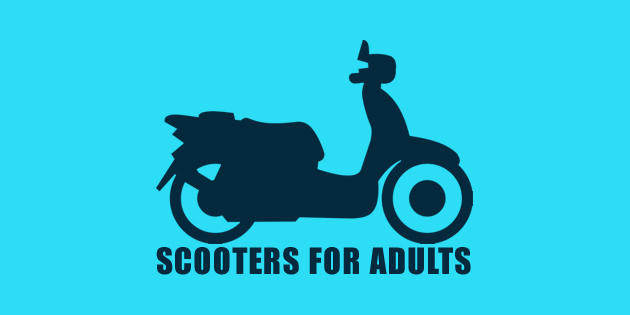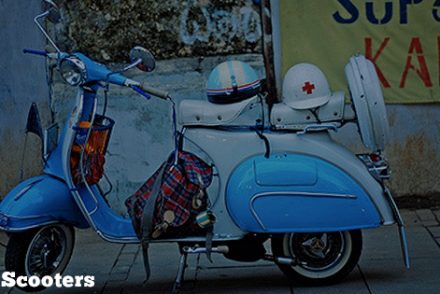New to scooters?
Don’t know where to look?
Well, you’ve come to the right place. This guide will go over the most commonly asked scooter questions and we’ll even go over 5 scooters that are popular with adults.
Enjoy!
How dangerous is riding a scooter?
These days, all forms of motorized transport are getting faster all the time, and scooters are certainly no exception.
Today, some scooters are faster than some proper motorcycles with comparable engine capacities were only ten years ago, so does that mean that nobody should ride a scooter, because of the perception that scooters are really, really dangerous?
The truth is that all forms of transport are inherently dangerous, but that does not mean that you should not ride a scooter to work, to do some shopping, or to go wherever else you need to be.
However, this does not mean that because some scooters are highway legal, that you should actually ride one on a highway. Since there are several things that count against scooters in the safety department that do not apply to proper motor cycles, let us look at some of the more important issues.
Small wheels make scooters unstable
Proper motor cycles are kept upright by the gyroscopic effect of their wheels, so the bigger and heavier a wheel is, the bigger the derived gyroscopic effect, even at low speeds.
This is not the case with scooters; their wheels are too small, and too light to generate a meaningful gyroscopic effect, which means that the rider has to balance the scooter with a conscious effort at low speed, lest the machine topples over.
Moreover, the windblast from passing trucks and other heavy vehicles is considerable, meaning that a scooter can easily be blown off course because the gyroscopic effect of the wheels is not strong enough to keep the machine stable.
Many scooter crashes are the direct result of windblast that literally blows scooters off the road.
Scooters have poor handling in emergencies
One of the main drawbacks of scooters is the fact that they cannot cope with sudden changes in direction in quite the same way that proper motorcycles can. Again, this is because of the limited stabilizing gyroscopic effect of the wheels.
Any sudden evasive maneuver is likely to cause the scooter to topple over in the direction opposite the turn, but the really bad news is that the possibility of this happening rises steeply as the scooter slows down, which is a direct result of the wheels not being able to keep the machine upright.
Scooters have bad brakes
Even though many high-end scooters have ABS brakes these days, the fact remains that the small diameter of their wheels often makes their brakes ineffective. This is not to say that scooters have no brakes; far from it, but scooter brakes are generally not able to execute emergency stops safely without upsetting the machine’s balance on the one hand, or the tires losing traction on the other, and especially if the rider is inexperienced.
The brakes on proper motor cycles are more effective because the effect of the ratio between the diameters of their brake discs, and their wheels is far more effective than what is possible to achieve on a small scooter wheel. The ruling principle here is this; the bigger the brake disc is relative to the overall diameter of the wheel, the less brake force is required for the brakes to be effective.
However, there is point at which larger discs become dangerous, because an oversized disc can cause the wheel to lock because the brakes work too well. Unfortunately, some manufacturers of scooters often exceed this point of diminishing returns with regard to the size of the brake discs on their scooters, meaning that the small contact patch on a scooter tire is often unable to transmit braking forces to the road surface effectively, causing wheels to lock up, and an almost certain crash.
In the interest of fairness though, it must be stated that not all scooters suffer from this built-in defect, but be aware that some scooters have brakes that could kill you.
Scooters have poor acceleration
Acceleration is not much of an issue if you only ever ride on quiet residential streets. However, the poor rate of acceleration on most scooters could cause dangerous situations on a highway, or even city streets, where the ability to accelerate rapidly away from a dangerous situation is often the only defensive strategy available to a rider.
For various reasons, car drivers often don’t see scooters, and those that do, often don’t care about the welfare of a scooter rider. In practice, this means that should a car turn into the road in front of a scooter driver, his poor brakes and his poor rate of acceleration could conspire to make it impossible for him to avoid an almost certain crash.
The four points listed above are the main causes of crashes involving scooters, but none of them should discourage anybody from buying, and riding a scooter. However, there are many other causes of scooter crashes, many of which are easily avoided, as a recent study has shown.
Tips on riding a scooter safely
Scooters may not be for everyone, but there is no doubt that a scooter is a viable mode of transport if you want to save costs on fuel and vehicle repair/maintenance bills. However, there is little point in saving on gas if you end up having to pay huge medical bills because you were seriously injured in a scooter crash, which is why we have listed some tips on scooter safety below.
By following these tips, you should be able to avoid many, if not most, potentially dangerous situations.
Get some training
There is nothing particularly difficult about riding a scooter, since you only have one control- the twist throttle- with which to concern yourself. However, it is precisely because riding a scooter is so easy that so many avoidable crashes occur, since many, if not most riders have no idea about the limitations that scooters suffer from.
In many states, scooter drivers don’t need any sort of training to have their licenses endorsed to allow them to ride a scooter; in fact, some states don’t even require an endorsement for some classes of scooters. Although some states have taken steps to remedy this situation, not all have done so, which does nothing to prepare a large number of scooter riders for their first ride on a scooter in city traffic.
Scooters are nothing like motor cycles, or any other mode of transport for that matter, which is why it is crucially important to undergo at least a couple of hours of professional instruction to be able to make allowances for a scooter’s poor handling and acceleration, often-bad brakes, and instability at low speeds.
Wear protective clothing at all times
Some states require scooter riders to wear eye protection, but you need more than eye protection, since faling off a scooter at 35 m/ph is the same as falling of a motor cycle at the same speed.
A fall at 35 m/ph is quite enough to break bones, including your skull, remove large sections of skin while sliding over the ground, and cripple or even kill you should you hit an obstacle while sliding to a stop.
While falling of your scooter cannot always be prevented, you can minimize the potential to sustain serious injuries by wearing a high-quality crash helmet, a leather jacket to protect your skin, denim trousers to protect more skin, and lace-up leather shoes to protect your feet.
Many serious injuries can be avoided simply by wearing suitable clothes while riding, so don’t worry about your image- worry about your continued good health instead.
Avoid riding in rain or snow
The problem with many scooter tires is that they are only a little better than the tires found on wheelbarrows.
In many cases, scooter tires are simply not designed to cope with rain or snow effectively, and if you add to this the fact that the contact patch of a scooter tire is about the same size as a book of safety matches, it should be obvious that riding on wet or slippery surfaces is not a good idea, regardless of the class of scooter involved.
What CC scooter should you purchase?
This is much like asking how long a piece of string is, but if engine size is the only concern, we can give you some pointers on what to buy that will best suit your needs.
50cc scooters
These are generally not suited to adults since they are underpowered, and have a limited load carrying capacity.
All 50cc scooters are however suitable for use by school students, or by persons of with a slight build, provided they are not ridden in city traffic, or used to carry passengers or loads in conditions where the added weight could interfere with acceleration and handling.
125cc/150 cc scooters
Scooters of this class are generally well suited to conditions where their better acceleration and handling make it easier (and safer) to cope with urban traffic.
However, even though some scooters in this class are supposedly highway legal, almost none of them are so in real-world traffic conditions, so do not venture onto highways with any scooter of this class.
250cc scooters
While it is possible to use most 250cc scooters on highways, we do not recommend it, because even scooters of this class have serious stability issues.
However, for adults requiring an alternative mode of transport to get to work and back, this would be great choice, provided of course that the commute does not take in sections of busy highway.
250cc scooters are also powerful and sturdy enough to carry two persons and some basic camping equipment easily over extended distances.
In fact, using a 250cc scooter is an excellent way to explore the back roads of the country, and there are many instances of people using 250cc scooters to cross entire continents, Africa excluded, since there are virtually no roads there north of Botswana.
Other sizes
Today, there are scooters available in engine sizes all the way up to 800cc, but even these have stability issues due to their relatively small wheels. However, if stability is not an issue for you, and if you are willing to pay the often-hefty asking price for a top-of-the-line scooter, you can get one that is as comfortable to ride as any proper touring motor cycle.
Not to mention the fact that some scooters have nearly as much advanced technology built into them as the average family sedan.
Most scooters above 300cc have no problem keeping up with highway traffic, and in some cases, the larger scooters can even outrun highway traffic, although we don’t recommend that you do this. Moreover, scooters of this size can easily carry up to 450-500 lbs, which makes them ideal for longer camping trips that require a sizable load that can be stowed in detachable cargo trunks or panniers.
Ultimately, though, your final choice will depend on your particular needs and circumstances, including how much you are willing and/or able to pay for a scooter. Bear in mind though that a high price does not necessarily mean high quality.
There are many expensive scooters available that are poorly constructed, or have serious reliability issues, but there are also many excellent scooters available that do not require you to mortgage your house to buy one.
The trick is to shop around, but even better, if you see a scooter you like, ask the owner about it. Get as much information from the owner as you can on issues like running costs, reliability, handling, servicing centers / parts availability, and load carrying capacity.
The best information is first-hand information, so get as many questions from as many different scooter owners as it takes for you to be sure that you are making a decision that is right for you.
Can you drive a scooter on the highway?
Just because some scooters are highway legal, it does not mean that you should ride one on highways, and especially not on highways that carry fast-moving traffic.
The term, “highway legal”, as it relates to scooters is one of the most misleading terms ever invented, because in the world of scooters, “legal” seldom translates into “safe”. You may have the cc’s, all the required lights and signals, and perhaps even the speed, but what you don’t have is stability, which is a dangerous thing not to have.
For instance, one of the most dangerous places to be on a scooter is alongside a large truck, or other heavy vehicle. If the windblast does not blow you off course as it passes you, the turbulence around the trailer could force you into a position where you could easily make contact with the trailer, which is a very bad thing indeed.
Always remember that the turbulence and buffeting around all heavy vehicles can be severe, and since your scooter’s wheels cannot keep your scooter stable, there is a good chance that you might end up under such a vehicle, which is the worst possible thing that could happen.
Moreover, it might very well be impossible to accelerate away from the truck because there might be traffic in front of you, or you may simply not have the power.
Riding quiet sections of Interstate Routes
Some highways are so quiet that you may wonder why they were built at all, but regardless of why they were built, these routes are generally in excellent condition, and the odd vehicle you may encounter early on a Sunday morning ride should not pose any danger or threat at all.
Moreover, seeing the country from the seat of scooter that is purring along sedately is one of life’s greatest pleasures, and we believe that everyone should try it at least once.
Nonetheless, how well such a trip goes depends in large part on your level of riding skill, so we recommend that you should have ridden at least a couple of thousand miles before you undertake a trip that takes you a long way from home.
Anything can happen on such a trip, and you should be fully confident in your riding skills, as well as your ability to make at least some minor repairs at the roadside. To get you started on the process of honing your riding skills, we present you with a selection of scooters below that we believe will answer most, if not all of your needs.
Our picks for the best scooters for adults
The scooters in this selection may not be pocket-rockets, but they are all made by reputable manufacturers, and they are all capable of sustained high-speed travel while carrying a passenger.
Note however, that while these are all “highway legal” in the sense that their engines displacement is 150cc or slightly more, their primary purpose is to provide an alternative means of transport in the suburban setting.

2013 Honda PCX150
Specifications
Engine: 153cc, liquid cooled 4-stroke
Starter: Electric
Fuel: Regular gasoline
Fuel capacity: 1.6 gallons
Transmission: Constantly Variable Automatic
Brakes : Hydraulic on the front, and drum brakes on the rear
Wheel size: 14” on both wheels
Wheel base: 51.8 inches
Storage capacity: 25 liters (Enough to hold any helmet)
Reviewers of this scooter agree that it offers zippy performance, and that it easily keeps up with town or city traffic. Although some users have reported positively on the PCX150’s highway capabilities, none seem overly enthusiastic about repeating the experiment.
However, this scooter excels in city/town traffic, where its power, acceleration, and effective brakes makes it a pleasure to ride.
At 286 pounds, the PCX150 is on the hefty side, but its 14”-inch wheels, and linked brake system brings it to a rapid stop without any noticeable brake fade after several emergency stops.
Worth noting is the fact that the left brake handle activates both the front and rear brakes, an innovation that could take some time getting used to. Reported top speed is around 70 m/ph, with fuel consumption varying between 80 and 90 miles per gallon.
2015 Lance Cali Classic 150
Specifications
Engine: Air cooled, 149cc, 4-stroke
Starter: Electric with kick start back-up
Fuel: Regular gasoline
Fuel capacity: 1.37 gallons
Transmission: Fully automatic CVT
Brakes: 180mm disc brake on the front, and drum brake on the rear
Wheel size: 12 inch
Wheel base: 51.6 inches
Although it takes the Cali Classic 150 some time to reach its top speed of around 60 m/ph, its smooth power delivery and comfortable ride position goes a long toward compensating for its lacklustre performance.
This scooter has a well-deserved reputation for reliability, great handling, and effective brakes, but the small, 12-inch wheels sometimes produce alarming stability problems on uneven surfaces.
Official sources state that this scooter will give you around 87 MPG, and that the fuel capacity is 1.37 gallons, which should be enough to get you to where you are going.

2014 Piaggio Fly 150
Specifications
Engine: Air cooled, 149cc, 4 stroke
Starter: Electric
Fuel: Premium gasoline
Fuel capacity: 1.8 gallons
Transmission: Fully automatic CVT
Brakes: Hydraulic disc brakes on the front, drum brake on the rear
Wheel size: 12-inch
Wheel base: 52.2 inches
By all accounts, the Piaggio Fly 150 is a practical and efficient alternative to using a car or public transport for daily commutes.
Its state-of-the-art 4 stroke engine is renowned for its reliability and fuel efficiency, with a consumption figure of 104 MPG. However, its small, 12-inch wheels could cause some instability on uneven surfaces.
Top speed is 61m /ph, the hydraulic suspension offers excellent handling, while the large, 220mm front brake disc and dual-piston caliper provides excellent stopping power. The rear wheel is fitted with a 140mm drum brake.

2011 E-Ton Beamer 150
Specifications
Engine: Air cooled, 149cc 4-stroke
Starter: Electric with kick-start back-up
Fuel: Premium gasoline
Fuel capacity: 1.5 gallons
Transmission: Fully automatic CVT
Brakes: Disc brakes on both wheels
Wheel size: 12-inch
Wheel base: 49.6 inches
There is little doubt that E-Ton scooters rank among the best scooters money can buy, with the 2011 T-Ton Beamer being the most popular. In stock trim, the air cooled, 149cc 4-stroke engine delivers an outstanding 104 MPG, and a top speed of 70 m/ph.
However, due to the demand for this scooter, finding one in reasonable condition might be problematic, and it should be remembered that 30 000 miles is about the point at which you could expect to find worn out engines and CVT transmissions.
Nonetheless, E-Ton scooters are known for their excellent handing, brakes, and ride quality, so it might be worth your while spending a little money to get a used Beamer 150 scooter running again.

2014 Kymco Super 8 150
Specifications
Engine: Air cooled, 149cc 4-stroke
Starter: Electric with kick-start back-up
Fuel: Premium gasoline
Fuel capacity: 1.3 gallons
Transmission: Fully automatic CVT
Brakes: Hydraulic disc brake on the front, drum brake on the rear
Wheel size: 14-inch
Wheel base: 53.7 inches
Kymco is one of only a few manufacturers that use 14-inch wheels on their scooters, which make for improved stability and handling on uneven surfaces.
Sadly though, much of the benefit of the improved handling is negated by the relatively poor brakes on the Super 8 150, which is compounded by the hard suspension, and high riding position.
Moreover, this Super 8 150 was designed with taller riders in mind, and persons with an instep of less than 29 inches might find it difficult to mount the scooter.
For all its faults, the Kymco Super 8 150 is a sports oriented scooter that has a well deserved reputation for reliability, and its sporty styling goes a long way toward compensating for minor design faults.
Fuel consumption is around 69 MPG, which is average for this class, as is the top speed of around 61 m/ph. This Kymco scooter is C.A.R.B. compliant, which makes it legal in most, if not all states.
One more thing
The four possible scooter choices listed here represent high-end scooters in terms of build quality, handling, reliability, and of course, popularity, which could make it difficult to find one of these scooters.
Nonetheless, if you find one, bear in mind small 4 stroke engines wear out a lot sooner than comparable 2 stroke engines, which makes it important not to buy any 4-stroke scooter just because it looks good. The engine might be seriously worn, even if the scooter’s mileage is relatively low, so be extra careful of this trap.
Also remember that OEM parts are not always readily available, and if they are, they are usually expensive, so the scooter you buy must be in excellent condition, and ideally, it should not need anything replaced or repaired, before it runs well.
All scooters require regular maintenance and servicing, which makes it important to obtain at least some proof that regular maintenance was carried out, and that basic requirements like regular oil changes were performed on time. If you can find all of this in a used scooter, congratulations, and enjoy the ride!
Image Credit: The Honda PCX150 image was created by Khaosaming.





No Comments